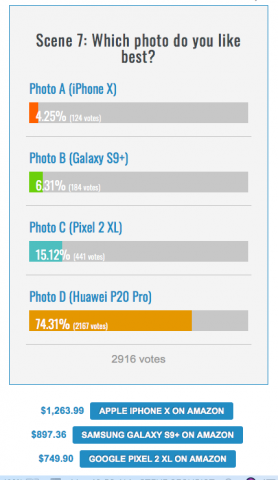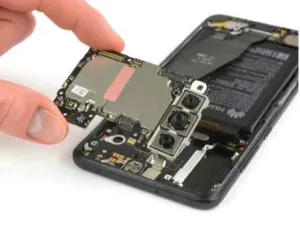In case you missed it we’ve been doing a lot of coverage on China-based Huawei’s rise to smartphone prominence and it recently edged out Apple as the number two selling brand worldwide. In Q2 2018 Huawei logged a 15.8% worldwide market share to Apple’s 12.1%, based on IDC’s recent numbers.

The company grew 40.9% in the recent quarter (YoY) mostly at the expense of Samsung’s -10.4% (YoY drop) from 22.9% world wide market share down to 20.9% in Q2-18. Samsung shipped 71.5M units to Huawei’s 54.2M. Apple reportedly shipped 41.3M units and ranked third behind Huawei for the quarter, on year over year growth of 0.7%.
It turns out that what’s helping drive those high sales numbers in China and other BRIC nations (Huawei phones are not for sale in the US) is a fantastic tri-lens camera that blows the socks off the competition. In a blind test voters evaluated seven different scenes, ranging from close up outdoor nature, to intense color billboard shots. They were taken with each of the four smartphones then offered in a blind comparison for vote.

The results, the Huawei P20 Pro smartphone with its 40MP camera sensor with 6GB RAM, and is powered by a HiSilicon Kirin chip technology (with Octa-core running at 2360 MHz.) It outperformed the competition hands down gaining a whopping 74.3% voter preference overall (see chart below). The P20 Pro sells in China and other regions for around $700, well under the Apple iPhoneX that offers a 12MP sensor and runs the Apple Aa11 Bionic chip, a Hex-core 2390 MHz chip, (but with 3 GB less RAM than the P20.)
Data is from Nik Todorov’s smartphone camera shoot-out done in April 2018, over at phonearena.com. This evaluation focused on the Huawei flagship P20 Pro, plus top sellers in the smartphone space including Apple’s iPhone X, Samsung’s Galaxy S9+, and Google’s Pixel 2 XL. (The camera also impressed the very picky folks at DXO Mark)
Here is a summary of the voting in the blind test of camera image quality by phone maker.

 One of seven images tallies from blind test of smartphone camera quality, source: phonearena.com
One of seven images tallies from blind test of smartphone camera quality, source: phonearena.com
More bang for the buck.
Here’s what Huawei offers its users for the relatively low price compared to the competition:
- 6.1-inch OLED touchscreen with 2240 × 1080 resolution and an aspect ratio of 18.7:96.
- Octa-core Kirin 970 with Mali-G72 MP12 GPU and a dedicated NPU
- Triple camera 40 MP + 8 MP + 20 MP, ƒ/1.6 and ƒ/2.4 main camera unit by Leica
- A whopping 24 megapixel ƒ/2.0 selfie camera
- 128 GB storage and 6 GB RAM
While the company is not on any official government ban list, they have been under criminal investigation by the USDOJ (department of justice) for violating US sanctions, and department of defense concerns of what the government calls “cyber subterfuge.” in 2017, the company did plead guilty and paid $892M in penalties (along with ZTE) for “sanctions busting” activities. For details see the full article in the WSJ, April 2018.
Truth be told, there is a lot to like in the flagship Huawei P20 Pro smartphone, but here in the US this device is persona non grata due in part to its aggressive telecommunications sales and support in Iran in direct violation of global sanctions against that country in 2011. The company may have made a strategic decision to write-off the US market and go for global hegemony outside the USA. Hopefully as some point the air will clear, and consumers on this side of the pond will have the benefit of increased completion in the smartphone device space. – Steven Sechrist
IDC: Overall Smartphone Market Declines 1.8% in 2018 Q2
IDC: Tablets Shipments Continue to Decline in the Second Quarter of 2018
Huawei will Use BOE Flexible OLED Panels for Foldable Smartphone

